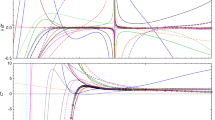Summary
Recent results concerning phase stability of simple and charged fluid mixtures are reported. The applied theoretical appraoches are the hypernetted-chain (HNC) approximation and the mean spherical approximation (MSA). The MSA predictions for the existence of critical points and spinodal turn out to be qualitatively correct in all cases investigated although the thermodynamic inconsistency of the theory forbids a quantitative estimate of the location of these features. The determination of the phase stability conditions is also performed in the more accurate HNC, through an extrapolation procedure of the available results for theq=0 limit of the concentration-concentration structure factorS cc(0). Such an extrapolation is necessary since, as also found by other authors, the algorithm of solution becomes unstable in a region of the parameter space which, at high densities, can be identified with the spinodal. The same procedure allows us to establish that the HNC exhibits a power law behaviour in the high-density limit. Some applications to model systems which mimic real mixtures, and the related comparison with the experimental results, are discussed throughout.
Riassunto
Vengono riportati alcuni recenti risultati concernenti la stabilità di fase di miscele di fluidi semplici e carichi. Gli approcci teorici utilizzati sono l'approssimazione hypernetted-chain (HNC) e l'approssimazione sferica media (MSA). L'MSA predice in maniera qualitativamente corretta l'esistenza dei punti critici e dello spinodale per tutti i casi studiati, anche se l'inconsistenza termodinamica della teoria ne impedisce una localizzazione quantitativamente accurata. La determinazione delle condizioni di stabilità di fase viene effettuata anche attraverso la HNC, approssimazione più accurata dell'MSA, utilizzando una procedura di estrapolazione dei risultati disponibili per il limite aq→0 del fattore di struttura concentrazione-concentrazioneS cc(0). Una tale estrapolazione si rende necessaria poichè, come anche riscontrato da altri autori, l'algoritmo di soluzione diventa instabile in una regione dello spazio dei parametri che, ad alte densità, può essere identificata con lo spinodale. La stessa procedura permette di stabilire che la HNC manifesta un comportamento di legge di potenza nel limite di alte densità. Vengono anche discusse diffusamente alcune applicazioni a sistemi modello che approssimano miscele reali, e in relazione a queste, presentati confronti con alcuni risultati sperimentali.
Резюме
Приводятся недавно полученные результаты, касающиеся фазовой устойчивости смесей простых и заряженных жидкостей. Применяются два теоретических подхода: приближение «гиперсетевой цепочки» и среднее сферическое приближение. Оказывается, что предсказания среднело сферического приближения для существования критических точек и точек возврата оказываются качественно правильными для всех исследоованных случаев, хотя термодинамическая несогласованность теории запрещает делать количественные оценки локализации зтих особенностей. Также определяются условия фазовой стабильности, в рамках приближения «гиперсетевой цепочки», используя процедуру зкстрополяции имеющихся результатов для пределаq=0 структурного фактораS cc (0). Такая экстрополяция необходима, так как алгоритм решения, как было получено также друлими авторами, становится неустойчивым в области пространства параметров, которая при высоких плотностях может быть индентифицирована с точкой возврата. Такая процеура позволяет показать, что приближение «гипесетвой цепочки» обнаруживает поведение, согласно степенному закону, в пределе высоких плотностей. Обсуждаются некоторые применения к модельным системам, имитирующим реальные смеси, и результаты сравнения предсказаний с экспериментальными данными.
Similar content being viewed by others
References
M. C. Abramo, C. C. Caccamo andG. Giunta:Phys. Rev. A,34, 3279 (1986).
K. Nakanishi, S. Okazabi, K. Ikari, T. Iguchi andH. Tanaka:J. Chem. Phys.,76, 629 (1982).
J. A. Schouten, A. Deerenberg andN. J. Trappeniers:Physica (Utrecht) A,81, 151 (1975).
M. Tau andL. Reatto:J. Chem. Phys.,83, 1921 (1985).
E. Bruno, C. Caccamo andP. Tarazona:Phys. Rev. A,35, 1210 (1987).
S. M. Foiles andN. W. Ashcroft:Phys. Rev. A,24, 424 (1981).
P. D. Poll andN. W. Ashcroft:Phys. Rev. A,35, 5167 (1987).
G. Stell, K. C. Wu andB. Larsen:Phys. Rev. Lett.,37, 1369 (1976).
C. Caccamo andG. Malescio:J. Chem. Phys.,90, 1091 (1989).
A. B. Bhatia andD. E. Thornton:Phys. Rev. B,2, 3004 (1970).
N. H. March andM. P. Tosi:Atomic Dynamics in Liquids (Macmillan Press, London, 1969).
C. Caccamo:Phys. Rev. A, in preparation.
C. Caccamo:J. Chem. Phys.,91, 4902 (1989).
G. Porte andJ. Appell: inPhysics of Amphiphiles: Micelles, Vesicles and Microemulsions, edited byM. Corti andV. Degiorgio (North Holland, Amsterdam, 1979).
C. Caccamo andG. Malescio:Phys. Rev. A,40 (Dec. 89).
J. De Swaan Arons andG. A. M. Diepen:J. Chem. Phys.,44, 2322 (1966).
C. Hoheisel:Phys. Chem. Liq.,9, 245, 265 (1980).
G. Zerah andJ. P. Hansen:J. Chem. Phys.,84, 2336 (1986).
Author information
Authors and Affiliations
Rights and permissions
About this article
Cite this article
Caccamo, C. Integral equation description of phase stability in simple and charged fluid mixtures. Il Nuovo Cimento D 12, 427–440 (1990). https://doi.org/10.1007/BF02453302
Received:
Issue Date:
DOI: https://doi.org/10.1007/BF02453302




